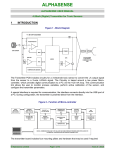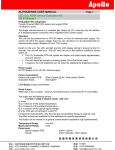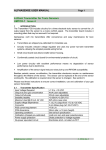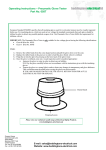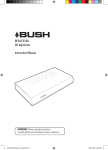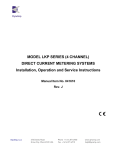Download ALPHASENSE USER MANUAL Toxic Sensor Evaluation Board 072
Transcript
ALPHASENSE USER MANUAL Toxic Sensor Evaluation Board 072-0128 Issue 4 Introduction This Evaluation Board accepts Alphasense “A”, “B” and “D” Series toxic gas sensors. The purposes of this evaluation board is to: • help first time users of toxic gas sensors to evaluate Alphasense sensors; • allow electronics designers to optimise potentiostat circuits by swapping op amps and changing load resistor; • let engineers study the effects of the bias voltage to optimise sensor performance; • operate as a single channel gas detector with analogue output for laboratory use. Before starting, please read these instructions carefully. You will need either four size AA batteries (alkaline batteries are recommended) or a bench DC power supply, capable of providing 6 to 9 volts at 1mA plus sensor gas hood, appropriate tubing and gas supply. Specification Power supply Current requirement Maximum output voltage Sensor type Sensors accepted Sensitivity rms. noise Offset (zero gas) voltage Output connector DC power connector PCB dimensions Mounting Operating conditions Power supply protection Sensor overload protection Load resistor Bias voltage No-power circuit Also required (not included) 6 to 9 VDC or 4 x AA batteries (alkaline recommended) < 300 µA (battery life for alkaline AA: 9000 hours- 1 year) ±2.5 VDC(±250µ A) negative output voltage for oxidation current three electrode electrochemical toxic gas sensors Alphasense A,B and D toxic gas sensors 10µV/ nA 0.5mV (100Ω), 0.7mV (33Ω), 1mV (10Ω load resistor) typically ±3 mV (equivalent to ±300 nA) screw terminals 2.1mm DC jack socket (positive pin) 93 x 115 mm four mounting screws into ABS box (100 x 119 x 41mm) -30 to 50°C, 15 to 90%rh (noise increases below -10°C) diode polarity protect: DC input & batteries two diode pairs protect sensor from op amp latching link selectable 10,33,47,100Ω normal 0V bias; user adjustable bias voltage via on-board potentiometer or external source. shorting FET between working and reference electrodes 150Ω batteries or DC source, sensor and gas hood, tubing, test gas Table 1. Performance and environmental specifications for Alphasense Toxic Sensor Evaluation Board Issue 4. Alphasense Limited Page 1 of 7 Evaluation Board Issue 4 1.0 Circuit Operation The attached circuit diagram shows a potentiostat circuit at the top and the power supply below. Refer to this circuit schematic during discussions below. The potentiostat circuit is powered by ± 3VDC regulated supply. This supply is generated from either four AA batteries or 6 to 9volt DC input. The DC input is diode protected against reverse polarity. The batteries are also diode protected via D4, a zenner diode. This zenner also disconnects the batteries when the circuit is continuously powered by a DC external source. The linear voltage regulator (U5) provides the +3V supply and U6 generates the -3V supply. To monitor the power supply, use test points TP4, TP5 and TP6, located to the right of the batteries. The potentiostat circuit consists of three parts: 1 Control circuit (U1A or U4A) 2 Measuring circuit (U3A plus U4B or U2A) 3 A FET which shorts the working electrode (also called sensing electrode or SE) to the reference electrode when power is removed from the circuit 1 The fixed voltage from the reference electrode is measured by either U1A or U4A (depending on whether you are using two single or one dual op amp: see section 5.3). The reference electrode (“Ref”) and working electrode (“SE”) are maintained at the same voltage; if a bias voltage is applied via P5/P6 and LK2 then the working electrode potential will be offset from the reference electrode voltage by the bias voltage. The control op amp ensures adequate current is provided to the counter electrode (CE) to balance the current generated at the working electrode, which is measured by U2A/U4B. Circuit noise is reduced by the combinations of resistors R6 and R7 with C1. You may find that only one resistor from R6 and R7 is necessary for your circuit design and the value of C1 may need optimising. 2 It is normal to add a shorting FET so that the reference and working electrodes are shorted together when power is removed from the circuit. If you remove LK1 then this option is disconnected, but this means that when you switch on the potentiostat circuit in the future the toxic gas sensor (SN1) will have been open circuit and may take a few hours to stabilise. If you are biasing a gas sensor (see section below) then when you switch off the circuit the reference and working electrodes will be shorted together. When you reapply a bias voltage in the future it may take a few hours to re-stabilise to the bias potential. Normally, no bias voltage is applied to the sensor via J2 and LK2 is fitted between pins 1 and 2. 3 The measuring circuit is traditionally a single op amp. However, to offer maximum flexibility in this evaluation board a two-stage op amp configuration has been used. The second stage provides 10x amplification of the signal. This can easily be checked by comparing the voltage of TP2 after the first stage and TP3 after the second stage. TP3 is directly connected to the output at the screw terminal J3 on the top of the board. The measuring circuit uses a combination of the load resistor (R1) plus the sensor internal resistance along with the internal capacitance of the sensor to establish a RC circuit. You can explore the effect of the load resistor by moving the link to LKA, LKB, LKC or LKD and measuring the rms. noise with an oscilloscope and the response time with a voltmeter or data-logger. Note that there is a compromise between fastest response time (lowest resistance load resistor) and best noise (highest resistance load resistor). Alphasense Limited Page 2 of 7 Evaluation Board Issue 4 A safety feature, D1 and D2, has been added to this circuit but is not normally implemented in standard instrument/gas detector circuitry. The two pairs of diodes protect the sensor from damage if the op amp clamps to the supply rail, hence driving too much current back into the sensor and ruining the sensor. Op amp clamping can occur if a sensor is plugged into an Evaluation Board that is already powered. Remember that whenever the batteries are in place the circuit is powered. It is good practice to remove the external power or at least one battery when plugging a sensor into the Evaluation Board. The attached schematic shows two parallel op amps for both control and measuring. You only use one op amp in each case, but the circuit allows for either a single dual op amp (labelled “DUAL” on the circuit board) or two single op amps (labelled U1 and U2). U3 is always a single op amp and is not swapped. You can swap to equivalent op amps with the same pin out during development (op amp pin out is shown in the schematic). The output voltage is inverted; that is, a negative voltage represents a positive current from the sensor electrode, and vice versa. 2.0 Connection and Wiring Plug the sensor into the sockets on the top of the board. The sensor sockets accept Alphasense type A, B and D toxic gas sensors. If you are using an external DC power supply then the DC jack socket J1 accepts a 2.1mm DC plug with positive centre. Power is 6 to 9 VDC, with less that 1mA current drain. The output voltage is supplied at J3 on the top of the board through two screw terminals with output and zero volts marked on the circuit board. Output is 10uV/ nA. See sensor sensitivity specification to determine the expected output signal for a specific gas concentration. J2 (labelled BIAS and 0V) is normally not connected, but if you are applying an external bias voltage then use J2 to inject the bias voltage. See section 5.4 below. 3.0 Power Supply The dual mode power supply accepts either batteries or an external DC source. Note the following points: • The circuit will operate as long as batteries are in place. There is no ON/OFF switch. If you are not going to use the circuit for a long time then remove at least one battery from the battery holder. New alkaline batteries will power the circuit for one year. • Although batteries provide a very low noise power supply source, since the ground is not common to your measuring instrument a common mode voltage may cause problems when using with a data-logger or meter powered by AC. If common mode voltage is a problem then connect a wire from the zero volt pin (TP6) to the ground point on your measuring equipment. • Avoid external DC voltage supplies with excessive noise or ripple. Do not supply mains AC power to this unit: this will destroy the Evaluation Board. Alphasense Limited Page 3 of 7 Evaluation Board Issue 4 4.0 Connecting the sensor to gas • Ensure there is a good gas seal between the sensor and the gas hood. • Ensure that the flow rate is sufficient: a flow rate is between 300 and 500 standard cubic centimetres per minute (sccm) are normally adequate. • When working with “sticky gases” (H2S, NO2, NO, Cl2) purge the hood and tubing with the test gas for up to one hour before beginning a test; otherwise, you will get a low output because the test gas will stick to the tubing and gas hood before it gets to the sensor. 5.0 Circuit options The evaluation board is designed to offer flexibility so that you can try different load resistors, op amps and bias voltages to optimise sensor performance and circuit design. Links, test points and op amp sockets are on the underside of the board. Unscrew the four corner screws to gain access to the underside of the board. 5.1 Load resistor The four links next to the sensor are labelled 10R, 33R, 47R and 100R. Swap the link to select the load resistor value. The combination of (sensor capacitance) and (sensor internal resistance plus load resistor) creates a RC circuit that affects the rms noise and the response time: response time increases linearly with load resistor and noise decreases as 1/RC with increasing resistance. If you need highest resolution then forfeit fast response time. Likewise, if fast response time is critical then reduce the load resistor, but then also reduce the resolution of your display to eliminate jitter. The graph below shows the effect of load resistance. 45000 40000 10 ohm s 35000 33 ohm s Output (nA) 30000 47 ohm s 100 ohm s 25000 20000 15000 10000 5000 0 0 50 100 150 200 250 300 350 400 t (s ) Alphasense Limited Page 4 of 7 Evaluation Board Issue 4 5.2 Shorting FET LK1 (at the bottom edge of the board) connects the shorting FET, Q1. This shorting FET is open circuit (> 1MΩ) as long as power is supplied from either the DC input or batteries. However, when power is removed then the FET short-circuits (with a residual resistance of about 150Ω) which ensures that the working electrode is maintained at the same potential as the reference electrode. This “zero bias” power-off state ensures that when you switch the circuit back on, the sensor is ready for use immediately. The FET is a p channel FET from Siliconix. Alternatives are J175, J176 or J177. If you are supplying a bias voltage, then when you switch off the circuit, the sensor will be zero biased and hence when you reapply a bias voltage it will take a significant time (up to several hours) for the sensor to re-establish equilibrium. Since the circuit takes so little power it is easiest to ensure that the batteries are in place, leaving the circuit operating, so long as your bias voltage remains on. 5.3 Swapping op-amps As you look at the circuit board from the underside you will see that there is a quadrant of four dual inline sockets for op amps. • The bottom right socket (U3) houses a single op amp that is the second stage of the two stage measuring circuit. You can swap this op amp (supplied: type OP90) for another equivalent single op amp but it cannot be swapped for a dual op amp. • The top left op amp socket (U4, labelled “DUAL”) accepts a dual op amp that operates as both the controlling op amp (U4A) and the first stage of the measuring op amp (U4B). You can remove the two single op amps (U2 and U3) and replace them with a dual op (see pin outs in the schematic). This option allows you to measure power consumption, zero offset and noise for a variety of single and dual op amps. 5.4 Bias voltage Normally Alphasense toxic gas sensors are operated in the zero bias mode: that is, the “BIAS” link LK2 (above the op amps) is connected between pins 1 and 2. However, certain sensors (such as NO sensors) require a bias voltage. Alternatively, sensor performance can be enhanced by adding a small bias voltage (BEWARE! performance can also be degraded when biasing!). This is especially useful when cross sensitivity to certain gases must be minimised. Consult Alphasense for further advice: remember that biasing a normally unbiased sensor may damage the sensor and voids the sensor warranty. If you wish to inject a bias voltage then change the link LK to position 2+3 for an external bias voltage, or 2+4 for the internally generated bias voltage. The internal bias voltage is easy to use and avoids potential ground loop problems, so use the internal bias voltage unless you are generating remotely time-dependent bias voltages. Using a digital voltmeter, measure the bias voltage at J2 if using the internally generated bias voltage. Adjust potentiometer VR1 to set the required voltage. The potentiometer swings from positive to negative; so zero bias is about halfway on the potentiometer. NOTE: for correct zero bias operation, use LK2 to link out the bias potentiometer. Do not use thVR1 to set zero bias voltage. Bias voltages can be set ±2mV that are adequate for settability; bias voltage stability is about ±1mV, which will avoid transient sensor performance due to fluctuating bias voltage. Alphasense Limited Page 5 of 7 Evaluation Board Issue 4 6.0 Noise, RFI/EMI Screening Ideally, the measuring and controlling op amps in a potentiostat are directly underneath the sensor because of the large capacitance of the sensor. This is not possible in this Evaluation Board because of the need for user access to the op amps. Therefore, note that the output noise from the circuit is not optimum: your design should be able to have lower noise than this circuit. Where possible, good practice has been followed in this circuit by, for example, designing copper grating on both sides of the PTH circuit board helps to reduce stray electric fields. Alphasense Application Note AAN 103 gives further advice on reducing noise and improving RFI/EMI screening. 7.0 Circuit Board Test Points If you are concerned about the performance of the circuit or wish to monitor sensor performance when gas is applied, then connect a high impedance voltmeter to the pins shown in the table below, and labelled on the circuit board. See attached schematic. Test Point Purpose 1 counter electrode voltage 2 output voltage (first stage) 3 output voltage (second stage) 4 +3V regulated supply 5 -3V regulated supply 6 0V regulated ground Table 2. Test Points for Toxic Sensor Evaluation Board 8.0 Calibration The output from the Evaluation Board is scaled as 10 uV/nA; for example, a CO-BF sensor will produce an output voltage of 1mV per ppm, since its sensitivity is 100nA/ppm. Note that toxic gas sensor sensitivities are typically interchangeable ±15%, so although the Evaluation Board accurately amplifies the output signal, you should calibrate to correct for sensor-to-sensor sensitivity variations. Alphasense maintains a database of the sensitivity of every sensor tested at Alphasense, but remember that sensitivity will drift downwards with time, between 0.5% to 2% per month, depending on the sensor type, relative humidity and gas concentration/ temperature conditions. To determine zero voltage and sensitivity: 1 First ensure that the power supply is connected correctly (or that batteries are fitted) and a good fitting flow-hood is in place. 2 Ensure that a high quality zero gas source is available (e.g. cylinder of artificial air or cleaned and scrubbed compressed air) and a bottle of calibration gas with validated accuracy (see Table 5 below). 3 Apply zero gas at 300 to 500 sccm for 10 minutes. Record the zero gas output. 4 Apply test gas at the concentration shown in Table 5 for ten minutes then record the span output. 5 Subtract the zero mV from the span mV, then divide the corrected voltage by the span gas concentration (as ppm) to determine: mV/ppm. This is your sensitivity. 6 If you apply the output voltage to an oscilloscope you can measure rms noise and convert this noise reading into sensor resolution (as equivalent ppm) by dividing this noise (as mV) by the sensitivity. If this resolution is not adequate for the required stability (i.e. jitter) of the display on your instrument/ detector then the sensor must be electrically screened to reduce noise susceptibility. Alphasense Limited Page 6 of 7 Evaluation Board Issue 4 Sensor CO-BF, CO-B1 CO-BX/AF CO-AX CO-AE H2S-AH H2S-BH H2S-A1/A2 H2S-B1 H2S-BE H2S-AE SO2-AF SO2-BF SO2-AE NO2-A1 NO2-B1 NO2-AE NO-A1 NO-B1 NO-AE Cl2-A1 CL2-B1 Full-Scale (ppm) 2000 2000 2000 4000 50 50 200 200 2000 2000 20 100 2000 20 20 200 20 20 1000 20 20 Sensitivity (nA/ppm) 100 70 50 20 1200 1600 750 370 90 105 500 350 100 370 900 350 FS output (µ µA) 200 140 100 80 60 80 150 74 180 210 10 35 200 7.4 22 70 FS output (V) 2 1.4 1 0.8 0.6 0.8 1.5 0.74 1.8 2.1 0.1 0.35 2 .074 0.22 0.7 100 370 900 100 7.4 22 1 .074 0.22 Cal point (ppm) 400 400 400 1500 20 20 20 20 400 400 20 20 400 5 5 100 5 5 400 10 10 Table 5. Toxic sensor outputs and calibration points 9.0 Maintenance The only maintenance required is changing the sensor-hood O-ring if it has been exposed to extreme environments for long periods (this O-ring should last the lifetime of the sensor in normal conditions). In addition, if the top dust/oil filter has become badly contaminated then contact Alphasense for replacement dust/oil filter. Replacement O-rings and dust/oil filters can be ordered by quoting the part number. Part Number 033-0002-00 024-0011-00 024-0018-00 Description Replacement O-ring (B series) Self-adhesive dust/oil filter (B series) Self-adhesive dust/oil filter (A series) Table 3. Replacement Part Numbering 10 Help If you need assistance then contact: Customer Support Alphasense Limited Sensor Technology House 300 Avenue West, Skyline 120, Great Notley, Essex, UK CM77 7AA Tel: +44 (0) 1376 556 700 - Fax: + 44 (0) 1376 335 899 E-mail: [email protected] Web Sites: English: www.alphasense.com - Chinese: www.alphasense.cn Alphasense Limited Page 7 of 7 Evaluation Board Issue 4







